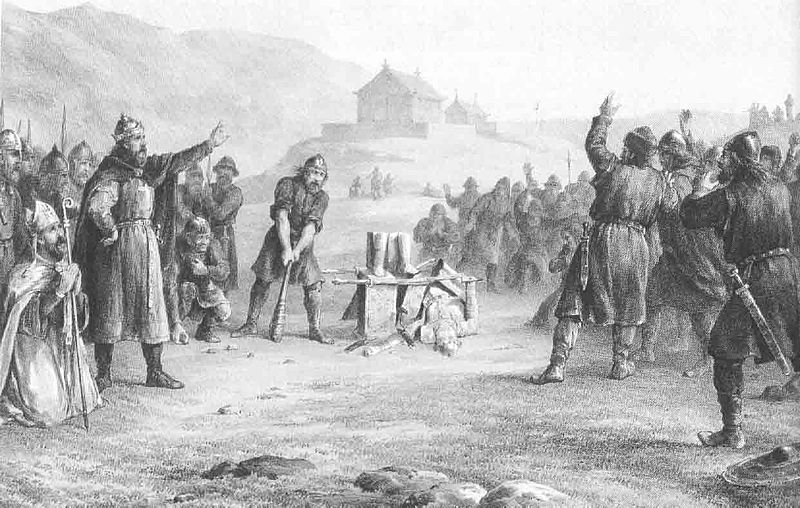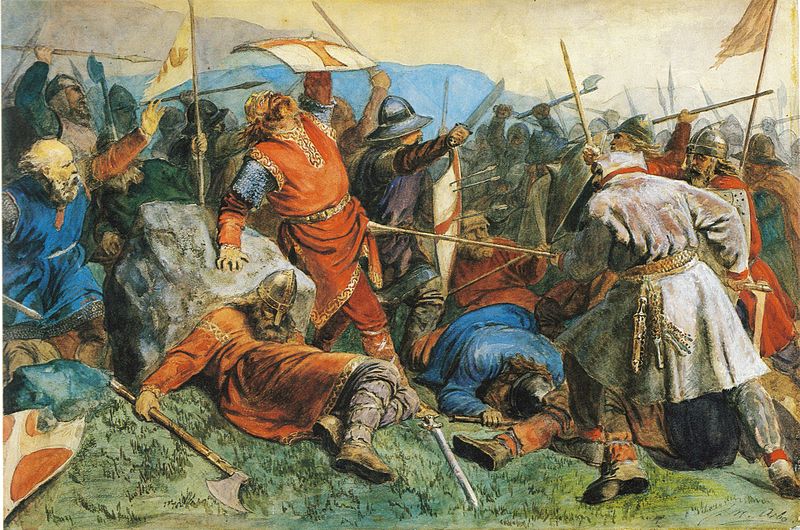St. Olaf Haraldson
Martyr and King of Norway (1015-30), b. 995; d. 29 July, 1030.
He was a son of King Harald Grenske of Norway. According to Snorre, he was baptized in 998 in Norway, but more probably about 1010 in Rouen, France, by Archbishop Robert. In his early youth he went as a viking to England, where he partook in many battles and became earnestly interested in Christianity. After many difficulties he was elected King of Norway, and made it his object to extirpate heathenism and make the Christian religion the basis of his kingdom. He is the great Norwegian legislator for the Church, and like his ancestor (Olaf Trygvesson), made frequent severe attacks on the old faith and customs, demolishing the temples and building Christian churches in their place. He brought many bishops and priests from England, as King Saint Cnut later did to Denmark. Some few are known by name (Grimkel, Sigfrid, Rudolf, Bernhard). He seems on the whole to have taken the Anglo-Saxon conditions as a model for the ecclesiastical organization of his kingdom. But at last the exasperation against him got so strong that the mighty clans rose in rebellion against him and applied to King Cnut of Denmark and England for help. This was willingly given, whereupon Olaf was expelled and Cnut elected King of Norway. It must be remembered that the resentment against Olaf was due not alone to his Christianity, but also in a high degree to his unflinching struggle against the old constitution of shires and for the unity of Norway. He is thus regarded by the Norwegians of our days as the great champion of national independence, and Catholic and Protestant alike may find in Saint Olaf their great idea.
After two years’ exile he returned to Norway with an army and met his rebellious subjects at Stiklestad, where the celebrated battle took place 29 July, 1030. Neither King Cnut nor the Danes took part at that battle. King Olaf fought with great courage, but was mortally wounded and fell on the battlefield, praying “God help me”. Many miraculous occurrences are related in connection with his death and his disinterment a year later, after belief in his sanctity had spread widely. His friends, Bishop Grimkel and Earl Einar Tambeskjelver, laid the corpse in a coffin and set it on the high-altar in the church of St. Clement in Nidaros (now Trondhjem).
Olaf has since been held as a saint, not only by the people of Norway, but also by Rome. His cult spread widely in the Middle Ages, not only in Norway, but also in Denmark and Sweden; even in London, there is on Hart Street a St. Olave’s Church, long dedicated to the canonized King of Norway. In 1856 a fine St. Olave’s Church was erected in Christiania, the capital of Norway, where a large relic of St. Olaf (a donation from the Danish Royal Museum) is preserved and venerated. The arms of Norway are a lion with the battle-axe of St. Olaf in the forepaws.
STORM, “Snorre Sturlason’s Olav den Helliges Saga”; MUNCH, “Det norske Folks Historie”; SARS, “Udsigt over den norske Historie”; DAAE, “Norges Helgener”; OEVERLAND, “Illustreret Norges Historie” (not reliable); VICARY, “Olav the King and Olav King and Martyr” (London, 1887).
NIELS HANSEN (1913 Catholic Encyclopedia)








